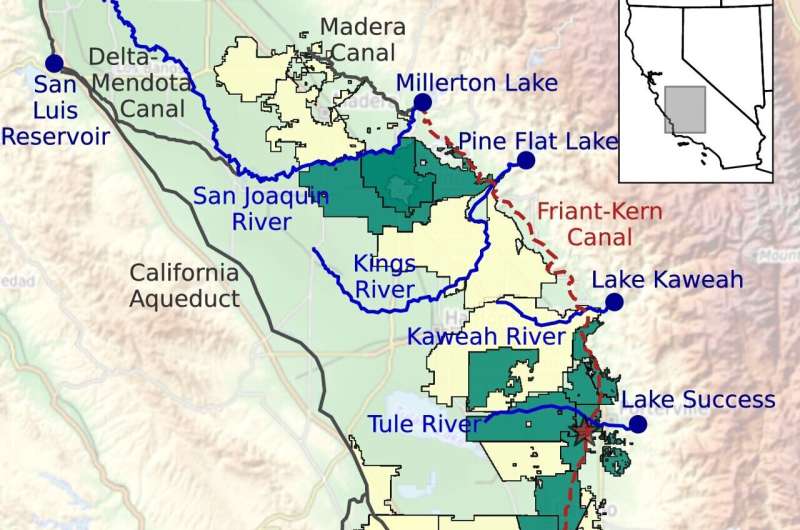
August 27, 2024 by David Nutt, Cornell University
Collected at: https://phys.org/news/2024-08-ai-benefits-partnerships.html
A Cornell-led research collaboration found that cooperative partnerships seeking to spread the cost burden of water infrastructure projects among regional stakeholders often end up forcing local partners to bear the brunt of underlying supply and financial risks.
That imbalance is caused by a range of factors, from institutional complexity to hydroclimatic variability. However, the researchers demonstrated that AI-driven computing and modeling algorithms can help design partnerships with substantially higher water supply benefits and a fraction of the financial risk.
To explore the tradeoffs inherent in these water infrastructure partnerships, the researchers, led by Patrick Reed, the Joseph C. Ford Professor of Engineering in Cornell Engineering, used the Friant-Kern Canal in California’s San Joaquin Valley as a case study.
The team’s paper, “Resilient Water Infrastructure Partnerships in Institutionally Complex Systems Face Challenging Supply and Financial Risk Tradeoffs,” was published Aug. 27 in Nature Communications. The lead author is Andrew Hamilton, a former postdoctoral researcher in Reed’s lab.
The implications go far beyond the Golden State, Reed said.
“This isn’t only a California story,” he said. “We have thousands of municipal water supply systems in the United States that are all confronting some level of uncertainty and financial risk, and we have a tremendous amount of our infrastructure that is aging out, in addition to confronting conditions it wasn’t necessarily designed for.
“How are we going to partner and come together on this? And who is going to confront the risks?” Reed said. “It’s a big problem. Our work is a step in the direction of highlighting some key concerns, but I think there’s a tremendous amount more broadly that could and should be done, especially given that most of the financial risk is going to be local.”
The combined effects of climate change, economic growth and regulatory changes have led to growing concerns related to water shortages in California and throughout the U.S., increasing the need for investments in new infrastructure, such as major canals and groundwater banking facilities. One popular approach for financing large-scale infrastructure projects has been collaborative partnerships—also called consolidation or regionalization—in which multiple water providers and users work together to finance, build and operate shared facilities.
“When you have potentially tens of independent regional entities managing water, the argument is, it makes sense in terms of efficiency and cost effectiveness to bring them together in cooperative partnerships, or to regionalize these distributed systems into a coordinated system, or to consolidate the planning and investment,” Hamilton said.
But given the complexity of so many interconnected systems, and the aggregated way the benefits are tallied, vulnerabilities for individual partners can be difficult to assess. To better understand the conflicting objectives and the tradeoffs, Reed, Hamilton and their co-authors—doctoral student Rohini Gupta, and Greg Characklis and Harrison Zeff from University of North Carolina, Chapel Hill—looked to California’s San Joaquin Valley region, which contains more than 4 million people and 5 million acres of irrigated farmland.
The researchers used AI-driven computing and modeling, or “multi-objective intelligent search,” to represent the system dynamics in 300,000 different candidate partnerships across more than 2,000 different scenario years, with a variety of plausible climatic conditions. The effort required a tremendous amount of data collection and development of the computational tools needed to get an accurate picture of the variables in play.
The team’s modeling showed that the cumulative estimates for cooperative partnership benefits can hide substantial inequalities and negative impacts for those partnering water providers that already have thin financial margins.
When it came to the most beneficial types of infrastructure projects, the researchers found that most partnerships can diversify their risks by investing in portfolios of both canal expansion and groundwater banking, rather than relying on only one strategy to address water scarcity.
The researchers also found that, compared to the current Friant-Kern Canal partnership, their algorithm could help identify “Goldilocks” configurations that would provide significantly more water and at a lower level of financial risk for all participants.
The researchers are sharing the algorithm freely in the hope that water infrastructure partnerships can better understand, and more effectively and equitably fund, their own projects.
“The new intelligent search tools and simulation frameworks have the ability to test many different alternatives in many different scenarios and really make the tradeoffs more explicit,” Reed said.
“We don’t want to come off as saying that we know more about the system than the people who are operating it,” Hamilton said. “The point of this is saying that the system is complex, and maybe we should take a step back and think about better ways to avoid unintended consequences when we’re making really large, and in many cases irreversible, investments.”
More information: A. L. Hamilton et al, Resilient water infrastructure partnerships in institutionally complex systems face challenging supply and financial risk tradeoffs, Nature Communications (2024). DOI: 10.1038/s41467-024-51660-8
Journal information: Nature Communications

Leave a Reply